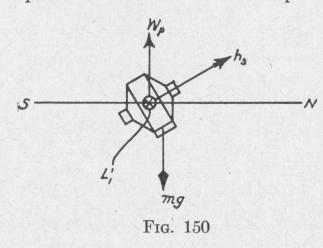194 NAVIGATIONAL COMPASSES
vertical through the center of the gyro and back of the plane of the diagram. A force F will act at this point in the direction of the roll. After a roll to the south-west, the center of mass of the pendulous mass will be at a point c' west of the true vertical through the center of the gyro and back of the plane of the diagram. A force F' will act as this point in the direction of the roll.
Each of the two forces F and F' may be replaced by three components, one in the north-south line, one in the east-west line and another in the vertical line. The components Fe and F,, in the east-west line, are equal, oppositely directed, and perpendicular to the gyro spin-axle. These forces produce no net torque on the spin-axle. The vertical components produce torques about the
spin-axle but these torques produce no deflection of a horizontal spin-axle.
After a roll to the north-east, the meridian component F.n of the F acting at c has a lever arm equal to the distance between its line of action and the spin-axle of the gyro. It produces a torque L on the gyro,
about a true vertical axis through the center of the gyro, in the counter-clockwise direction as seen when viewed from above. After a roll to the south-west, the component FS of the force F' applied at c' acts on the gyro with a torque L', in the counter-clockwise direction, about a true vertical axis through the center of the gyro. Thus, when the ship rolls in either direction, the gyro is acted upon by a counter-clockwise torque about a true vertical axis.
Since the direction of spin of a pendulous gyro-compass is clockwise when viewed from the south toward the north, and since the spin-axle tends to set itself parallel to the torque-axis and with the direction of spin in the direction of the torque, Art. 106, it follows that the north-seeking end of the spin-axle of the compass here considered will tilt upward while the ship rolls. The upward tilt raises the center of mass of the pendulous mass and moves it to the north of a vertical line through the center of the gyro. Figure 150 represents a view as seen when looking from the east toward the west. The weight mg of the pendulous mass develops
a torque L', which, in turn, produces a precessional motion wp. As a result, the north-seeking end of the spin-axle precesses westward.
It has now been shown that a pendulous gyro-compass on a rolling ship headed either north-west or south-east is deflected toward the west. In the same manner it can be shown that a pendulous compass on a ship headed either north-east or southwest will be deflected toward the east when the ship rolls. The spin-axle of a pendulous gyro-compass on a rolling ship steaming on any intercardinal course is deflected in the direction to make it more nearly parallel to the keel of the ship. The deflection due to pitching is in the direction opposite that due to rolling for a heading in any direction.
116. Quadrantal Deflection Due to Lack of Symmetry of the Sensitive Element. - It has been shown that, if the mass of a swinging pendulum bob is not distributed symmetrically with respect to the pendulum axis, the bob will tend to set itself in the position in which its moment of inertia with respect to the vibration axis is maximum (Art. 14).
In the case of all gyro-compasses having a sensitive element consisting of a single gyro, inert masses must be added to the sensitive element in order that the moment of inertia of the suspended system with respect to every horizontal axis through the center of mass may be equal. The mass, however, of a sensitive element comprising two or more gyros can be distributed symmetrically about the line through the center of mass and the center of oscillation. Neither a compass consisting of a single gyro with properly adjusted balancing masses nor a compass consisting of two or more properly placed gyros is subject to deflections due to centripetal forces developed during rolling and pitching of the ship.
117. The Suppression of the Quadrantal Error. - No feature of the gyro-compass has so taxed the ingenuity of physicists and designers as the avoidance or elimination of the quadrantal error. In Art. 115 it has been shown that the quadrantal error is due to the cumulative effect of vertical components of the precession of the spin-axle produced by the swinging of the compass system from side to side as the ship rolls or pitches. The quadrantal error would be avoided: (a) if the suspended compass system remained vertical however the ship rolls or pitches; (b) if the impulses imparted to the swinging gyro-frame by the rolling and pitching of the ship were applied only when the line through the center of the
